Slivers of Sao Paulo
Staring through a hotel window at a horizon stocked with skyscrapers, sipping cachaca cocktails & sampling slivers of sublime charred meats, soaking up carnaval beats; contemplating the cross-pollination of nations and the waves of immigration that made this place so utterly unique... one week to scrape the surface of this South American sprawl, before I leave Brasil yet again enchanted and enthralled...
Monday, November 7, 2011
Tanta Saudade
When I came here in 2007, I was completely captivated by Salvador do Bahia and it's many charms. Sao Paulo is a much different place, and falling in love with it a different proposition entirely. Part of the romance of Bahia is that it's position at the northeast of Brazil makes it one of the closest points from Portugal across the Atlantic. The Portuguese landed in Bahia and called it "the Bay of All Saints," and as the nexus of much of the slave trade between Africa and the Americas, Bahia is a place like no other. It's a spiritual crossroads, a haven for lost tribes to gather and reassemble themselves into the fragments of something new. There's a foreboding sense of time and age to the hills of the Pelhourinho, where the Portuguese established their religious capital in Brasil.... There's a medieval, very Catholic quality to the cobblestone streets of the Cidade Alta, and Bahia is stockpiled with magic and mystery. Sao Paulo? Comparing the two doesn't even seem feasible. Sao Paulo is its own creature...
Sao Paulo is the financial heart of the country, where the most money changes hands, where fortunes are made and lost, and where the landscape is dominated not by pure natural beauty but by the preponderance of skyscrapers that loom over everything. This place is crowded, and while there is much history here as well, this seems like its much more of a modern city of 20 million people clogged with cars and highways. Business rules the day. The beach is 70 km away, and you get the sense that people are here to pay their dues and stake their claims... But who am I to make these assertions? I barely ventured out of my hotel, and only saw tiny slivers of this city in between stretches of stupefying traffic. Just caught a glimpse of the place, enough to form a raw impression but not enough to ward off the fear I feel about the sheer size of this city. I hope to come back, at some point, to sample more succulent dishes, to venture out onto a dance floor, to stroll through the museums and do some damage to my credit card balances... Because there is much here to treasure and marvel at. To be honest, though, I'm hoping that after Bahia & Sao Paulo, my next trip to Brasil will take me to Rio, and Corcovado... Maybe I'll get insanely rich and can come down for the Olympics in 2016, or maybe in a few decades when the wife and I are retired, we can come spend a month here during Carnavale... Dare to dream. In the meantime I depart Brazil once again, ruminating for the millionth time on saudade, and wishing I had more time to tap into the infinite funk on offer here...
Candido Portinari

 Saw my first Candido Portinari paintings today. It's always a wonderful thing to discover a brilliant, influential artist who you've never heard of. Like Os Gemeos, this man was totally off my radar, and so it was a pleasure to see some of his work and have an opportunity to appreciate his aesthetic. Painters offer vivid windows into the worlds from which they come. I had the privilege of studying a small slice of art history with a magnificent high school history teacher (Mr.Craig, my eternal gratitude for the doors you opened), and I've always found it fascinating to think about how art reflects the values and contradictions of the society which it emerged from. Every civilization throws a bunch of impressions up onto canvasses and cave walls, and there's so much more there beyond the visual markings. I like the handful of pieces I saw from Portinari today. For a better collection of the art he left behind, check out this website.
Saw my first Candido Portinari paintings today. It's always a wonderful thing to discover a brilliant, influential artist who you've never heard of. Like Os Gemeos, this man was totally off my radar, and so it was a pleasure to see some of his work and have an opportunity to appreciate his aesthetic. Painters offer vivid windows into the worlds from which they come. I had the privilege of studying a small slice of art history with a magnificent high school history teacher (Mr.Craig, my eternal gratitude for the doors you opened), and I've always found it fascinating to think about how art reflects the values and contradictions of the society which it emerged from. Every civilization throws a bunch of impressions up onto canvasses and cave walls, and there's so much more there beyond the visual markings. I like the handful of pieces I saw from Portinari today. For a better collection of the art he left behind, check out this website.
Jose de Anchieta

 Midway through our tour we stopped in Sao Paulo's historical city center, which is almost 500 years old. A Jesuit missionary named Jose de Anchieta was the founder of Sao Paulo, and you can still see some of the traces of the original cob and clay buildings he laid down almost 450 years ago. It's astonishing...and so was his life, spent converting hundreds of thousands of native Americans to Christianity. You can read about his life here... I've always admired people who set out into the wilderness without really knowing where they were headed. Although I rarely romanticize colonialism in any form, and the idea of 16th century missionaries converting the native Americans to Christianity doesn't sit particularly well with me, I still find myself thinking about what this man's life must have been like. Can you imagine landing on a new world with nothing but your book and convictions?
Midway through our tour we stopped in Sao Paulo's historical city center, which is almost 500 years old. A Jesuit missionary named Jose de Anchieta was the founder of Sao Paulo, and you can still see some of the traces of the original cob and clay buildings he laid down almost 450 years ago. It's astonishing...and so was his life, spent converting hundreds of thousands of native Americans to Christianity. You can read about his life here... I've always admired people who set out into the wilderness without really knowing where they were headed. Although I rarely romanticize colonialism in any form, and the idea of 16th century missionaries converting the native Americans to Christianity doesn't sit particularly well with me, I still find myself thinking about what this man's life must have been like. Can you imagine landing on a new world with nothing but your book and convictions? Here's Encyclopedia Brittanica's brief bio:
José de Anchieta, (born March 19, 1534, Canary Islands, Spain—died June 9, 1597, Espírito Santo, Brazil), Portuguese Jesuit acclaimed as a poet, dramatist, and scholar. He is considered one of the founders of the national literature of Brazil and is credited with converting more than a million Indians.
Anchieta came from a prominent Portuguese family and was even thought to be related to the founder of the Jesuit order, St. Ignatius Loyola. He was educated in Portugal and entered the Society of Jesus in 1551. He first arrived in Brazil on July 13, 1553....
Here's more from this site: http://www.manresa-sj.org/stamps/1_Anchieta.htm
The Steps of Anchieta (Os Passos de Anchieta) is one of the first Christian roads of the Americas. It is also a project of local people to reestablish and maintain this tourist, environmental, cultural, religious, and historical route. The Steps of Anchieta is a reconstruction of the 60 mile route that José Anchieta walked every 14 days along the coastline of the State of Espiritu Santo, between the Town of Rerigtiba, where lived for the ten last years of his life with the Temiminós Indians, and the Colégio de São Tiago in Vitória, where the Jesuits taught catechism and other subjects. The last time he traversed this route was in his funeral cortege, about 3000 natives carrying him the distance. They had nicknamed him Abará-bebe (The Holy Flier) because of the speed with which he walked. In 1998 a group of persons resolved to rescue that route and reestablish it, and then they began a large annual 4-day walk, averaging about 3,000 participants.
Oscar Niemeyer
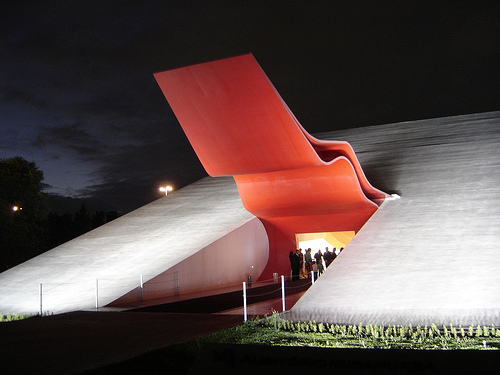
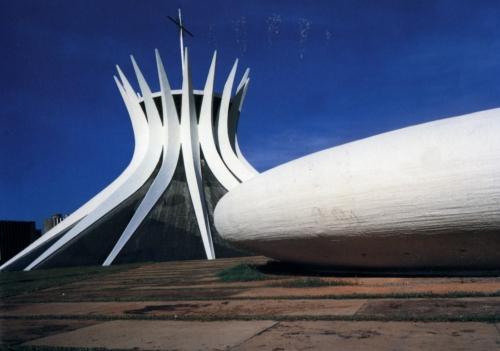

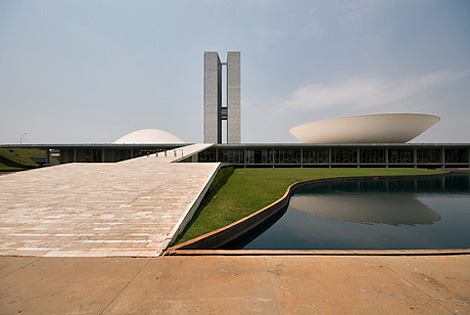
 Saw an astonishing building in the Parque do Ibirapuera designed by legendary Brazilian architect Oscar Niemeyer. His work is all over Sao Paulo, and he's still going strong, at age 103. His buildings are incredible to look at, to walk through, and to read about, and his proponents argue that Niemeyer is the world's greatest living architect. Check out his site here. There's a great profile on him here. Walking through his auditorium in the park (the first picture above) was a treat, as the space is magical and also quite deceptive visually. The building on the inside is not what you'd think it would be from the outside... Our guide informed us the red entrance way was inspired by the Rolling Stones' famous tongue logo...
Saw an astonishing building in the Parque do Ibirapuera designed by legendary Brazilian architect Oscar Niemeyer. His work is all over Sao Paulo, and he's still going strong, at age 103. His buildings are incredible to look at, to walk through, and to read about, and his proponents argue that Niemeyer is the world's greatest living architect. Check out his site here. There's a great profile on him here. Walking through his auditorium in the park (the first picture above) was a treat, as the space is magical and also quite deceptive visually. The building on the inside is not what you'd think it would be from the outside... Our guide informed us the red entrance way was inspired by the Rolling Stones' famous tongue logo...
Sunday, November 6, 2011
City without Billboards

In 2007, the Mayor of Sao Paulo banned outdoor advertising in the city. One of the things that really jumps out at you here is the presence of large scale public art, visible everywhere. Rather than being drowned out by marketing messages, as in cities like Shanghai and New York, you can drive and walk through Sao Paulo without feeling overwhelmed by people trying to sell you things. That's an amazing thing, for a city of this size, and it's worth thinking about. How much visual pollution does a city really need or want? Below is a video of Sao Paulo before and after the laws took effect... Here's an article from AdBusters on the whole ordeal of removing the scourge of billboards from the city's skyline. Food for thought.
Parque do Ibirapuera

 Our first stop of our tour was at the Parque do Ibirapuera, a gorgeous green space in the middle of the city filled with stunning architecture. The space houses Sao Paulo's modern art museum, a number of really beautiful pavilions, and a auditorium designed by Oscar Niemeyer. It's one of the largest parks in South America, covering 2 square kilometers, and it was a great way to start the day. Check out the park's website here.
Our first stop of our tour was at the Parque do Ibirapuera, a gorgeous green space in the middle of the city filled with stunning architecture. The space houses Sao Paulo's modern art museum, a number of really beautiful pavilions, and a auditorium designed by Oscar Niemeyer. It's one of the largest parks in South America, covering 2 square kilometers, and it was a great way to start the day. Check out the park's website here.
Os Gemeos

 Finished up the meeting and left for a day long tour of the city with my friend Kieran from Sydney. It proved to be a worthwhile investment of time and money, as I learned a lot and saw some things I would've otherwise missed in the short amount of time I spent here. One of the first things our guide pointed out were the huge highway side murals we passed while driving through the city, courtesy of a number of Sao Paulo's renowned graffiti artists. In particular, I learned about Os Gemeos for the first time. This twin brother duo has left a huge mark on the graffiti world, and Sao Paulo is filled with their work. Check out their website here to get a sense of what they do, or just google Os Gemeos to see a pretty amazing collection of their work. Below are a handful I like. It's always humbling and gratifying to discover artists worth admiring who you've never heard of before...
Finished up the meeting and left for a day long tour of the city with my friend Kieran from Sydney. It proved to be a worthwhile investment of time and money, as I learned a lot and saw some things I would've otherwise missed in the short amount of time I spent here. One of the first things our guide pointed out were the huge highway side murals we passed while driving through the city, courtesy of a number of Sao Paulo's renowned graffiti artists. In particular, I learned about Os Gemeos for the first time. This twin brother duo has left a huge mark on the graffiti world, and Sao Paulo is filled with their work. Check out their website here to get a sense of what they do, or just google Os Gemeos to see a pretty amazing collection of their work. Below are a handful I like. It's always humbling and gratifying to discover artists worth admiring who you've never heard of before...


Saturday, November 5, 2011
Sushi & Kinoshita
 Apparently Sao Paulo has some of the best sushi in the world, or so the guidebooks say when talking about the huge Japanese population here in this city. I love sushi, but my palette tends to stick to familiar rolls, so I thought it might be nice to try something new, in a place with a reputation for delivering the best. Ventured out to dinner with my friend Golf from Bangkok and Kieran from Leo Burnett Sydney, and we found ourselves dining on some really astonishingly good sushi at a restaurant called Kinoshita. Golf ended up picking up the bill, which was heftier than anticipated, but it was well worth it. (Spoken like someone who didn't end up paying.) We sampled some truly amazing sashimi, the best house-made shoyu I've ever tasted, and the whole meal was a series of delectable flavors that I will remember for a long time. Here's a review from about.com about this spot:
Apparently Sao Paulo has some of the best sushi in the world, or so the guidebooks say when talking about the huge Japanese population here in this city. I love sushi, but my palette tends to stick to familiar rolls, so I thought it might be nice to try something new, in a place with a reputation for delivering the best. Ventured out to dinner with my friend Golf from Bangkok and Kieran from Leo Burnett Sydney, and we found ourselves dining on some really astonishingly good sushi at a restaurant called Kinoshita. Golf ended up picking up the bill, which was heftier than anticipated, but it was well worth it. (Spoken like someone who didn't end up paying.) We sampled some truly amazing sashimi, the best house-made shoyu I've ever tasted, and the whole meal was a series of delectable flavors that I will remember for a long time. Here's a review from about.com about this spot:"Kinoshita, in Vila Nova Conceição, is a watershed in chef Tsuyoshi Murakami's career. The restaurant opened in early 2008 afforded this master of kappo cuisine the room and visibility he needed to firm his name at the top of São Paulo's Japanese cuisine.
The restaurant is named for chef Murakami’s father-in-law, Toshio Kinoshita, who immigrated to Brazil from his native Hokkaido in the early 1960s and owned the original Kinoshita on Rua da Glória, in Liberdade.
It was at the humbler and much smaller Kinoshita that chef Murakami perfected his style, surprising diners with bold tasting menus which gained a steady following by word of mouth.
Murakami, who was born in Japan and moved to Brazil as a child, started as a cook when he was 18 and worked in New York City, Tokyo and Barcelona before establishing his reputation in São Paulo."
Dinner @ Bar de arts

Finished up the meeting with a sublime meal at the Bar des Arts in Itaim. The highlight for me was a sublime lamb carpaccio drizzled with a mustard grain sauce... Wow. Between the fantastic food and the very strong caipirinhas, I was done early. Frommer's has this to say about the place:
"This is the place to go when you're trying to convince that would-be partner that, appearances to the contrary, you really do have a sweet and sensitive side. Set in a large garden beneath mature trees, the tables surround an Italian marble fountain whose soft gurgling combines with the flickering candlelight to create a feeling of magic."
There's a better review here. The food was fantastic.
Volkswagen - SpaceFox
Republica do Corinthians
From Wikipedia:
The History of Sport Club Corinthians Paulista starts on September 1, 1910, when a group of laborers in the neighborhood of Bom Retiro decided to create their own club. Their idea was to found a football team in which anyone could display his abilities in the sport, since back then, in the beginning of the 20th century, football in Brazil was considered to be an elitist sport, played mainly by British descendants and people who worked for British companies.
Under the lights of an oil lamp, in the "Rua dos Imigrantes" (Immigrants Street), the labourers Joaquim Ambrósio, Antônio Pereira, César Nunes, Rafael Perrone, Anselmo Correia, Alexandre Magnani, Salvador Lopomo, João da Silva, Antônio Nunes founded the first popular club in São Paulo.
Thursday, November 3, 2011
Sao Paulo Architecture
 Here's a great webpage profiling some of the amazing architecture of Sao Paulo:
Here's a great webpage profiling some of the amazing architecture of Sao Paulo:"From Oscar Niemeyer’s fiery Auditório Ibirapuera and powerful Memorial da America Latina to Lina Bo Bardi’s “art box” MASP, some of São Paulo’s most popular sites offer awe-inspiring examples of modern architecture. But the city’s passion for naked steel and concrete minimalism certainly doesn’t end there: in this guide, we’ve strayed from the tourist-beaten path to seek out the buildings locals love best.
These gems may not exactly be hidden, but they glitter all the same. All are in some way connected to the “Escola Paulista”, a highly influential generation of architects who grew up amid military dictatorship and rebellious communist influences, then revolted in the late 1960s, established themselves in the 1970s and 1980s, and finally inspired a another design wave at the dawn of the new century.
We’ll take you from their earliest influences right up to today—and right to the complex heart of São Paulo’s vibrant architectural scene."
City of Helicopters
Above the rooftops of a megacity: The helicopteromania of São Paulo
by Verena Brähler and Solveig Flörke
São Paulo, during the afternoon peak hour, a sheer endless queue of vehicles stretch along the Avenida Rebouças in São Paulo's upper-class neighbourhood Pinheiros. The exasperated drivers are literally stuck in the streets. They suspect they are part of a grim experiment that is testing the patience of drivers in a reactionary signal system where the green light on the traffic lights switches to red after a mere two seconds. Then suddenly they hear a scornful Zoom-Zoom-Zoom above their heads that easily drowns out the honks of the drivers. Looking up they see a helicopter dashing through the sky, unaffected by traffic and the frustration of the drivers.
With around 500 registered helicopters and 700 flights per day, the metropolitan area of São Paulo with its 20 million inhabitants has the biggest helicopter fleet in the world – even larger than in New York and Tokyo. Every minute the loud machines rumble over the rooftops of the skyscrapers and hotels. In Brazil's financial metropolis time is money and, with the streets being so highly congested, everyone that can afford it takes a helicopter for their day-to-day business operations. Most of the helicopters start their journey at the Campo de Marte airport. It takes only five minutes by helicopter from there to the centre of the city to the north (distance of 11.3km), compared to around 50 minutes by car.
Around seven million vehicles are responsible for the daily 150km 'Stop and Go' traffic in the municipality of São Paulo. Five million cars compete with 42,000 buses, 160,000 trucks and 875,000 motorbikes on the highways and roads of the megacity. According to the figures of the Municipal Secretary for Urban Development, the number of vehicles has more than quadrupled since 1980. And congestion is the price: whereas the average traffic speed during the afternoon peak hours was 24.9km/h in 1980, it is now only 14.8km/h.
Wednesday, November 2, 2011
Bon Yurt "Neon"
E Isso I
Feijoada
"The origin of the feijoada runs back to the sixteenth century with the introduction of slaves in Brazil. Slaves were used for many things, cotton production, cocoa production, rubber and with the goldrush boom for extraction of dimonds and mine digging.
The culinary culture of Africa was mixed with the European food traditions. The African slaves had the basic bean stew, the Portuguese added the linguiça (sausage), and the Indians added the farofa (toasted manioc flour). The result was a particularly "heavy" dish wich lasted long and gave the workers the energy they needed, the feijoada!"
Tuesday, November 1, 2011
Sounds from Sao Paulo (Vol.2)
Fogo de Chao
 After Vai Vai performed at the agency, we headed out for some Brazilian barbeque at Fogo de Chao. If you like a good cut of meat, and have never visited a South American churrascaria, you're missing out... Fogo de Chao translates to "fire of the earth," and has become a worldwide hit since launching in Brazil in 1979. It's a barbeque based on the gaucho (cowboy) way of barbequing meat, and features waiters wandering around with meat on spits dispensing slivers of steak to anyone who indicates they want a piece. It's basically an all-you-can-eat steakhouse with tableside rodizio service. Meat overload, but with an extensive salad bar for any vegetarians who happen to come along. We shared a fabulous meal, and retired back to the hotel stuffed full of rare cuts and good red wine... Ahhh...in my experience, the South Americans are unrivaled when it comes to steaks...
After Vai Vai performed at the agency, we headed out for some Brazilian barbeque at Fogo de Chao. If you like a good cut of meat, and have never visited a South American churrascaria, you're missing out... Fogo de Chao translates to "fire of the earth," and has become a worldwide hit since launching in Brazil in 1979. It's a barbeque based on the gaucho (cowboy) way of barbequing meat, and features waiters wandering around with meat on spits dispensing slivers of steak to anyone who indicates they want a piece. It's basically an all-you-can-eat steakhouse with tableside rodizio service. Meat overload, but with an extensive salad bar for any vegetarians who happen to come along. We shared a fabulous meal, and retired back to the hotel stuffed full of rare cuts and good red wine... Ahhh...in my experience, the South Americans are unrivaled when it comes to steaks...
Vai Vai throws done some Carnavale Color
 Following a few quick cocktails on the top floor of Leo Burnett, we were pulled into a conference room and shown a rather incredible presentation about our Brazilian office, detailing their new business model and projected growth numbers for the coming year. There's nothing like new blood to infuse a business with new energy. At the very tail end of the presentation, we were told there was a surprise waiting for us, and Tailor Made CEO Paulo Giovanni threw open the doors to reveal a crew of drummers and 7 statuesque women in full-on carnavale costumes. A righteous, riotous party ensued.... The crew was from the Vai Vai Samba School, a championship escola de samba here in Sao Paulo.... Wow. Carnavale has long been something I've longed to experience first hand, because there are no people in the world who know how to party like the Brazilians. Gotta love a people that take their beats seriously.
Following a few quick cocktails on the top floor of Leo Burnett, we were pulled into a conference room and shown a rather incredible presentation about our Brazilian office, detailing their new business model and projected growth numbers for the coming year. There's nothing like new blood to infuse a business with new energy. At the very tail end of the presentation, we were told there was a surprise waiting for us, and Tailor Made CEO Paulo Giovanni threw open the doors to reveal a crew of drummers and 7 statuesque women in full-on carnavale costumes. A righteous, riotous party ensued.... The crew was from the Vai Vai Samba School, a championship escola de samba here in Sao Paulo.... Wow. Carnavale has long been something I've longed to experience first hand, because there are no people in the world who know how to party like the Brazilians. Gotta love a people that take their beats seriously.intricate rhythms & fine women unleashing skin
rhinestones & feathers & a carefully orchestrated din
drummers & dancers doing their thing
dripping samba so sexy that the sight of it stings
Below is an online documentary clip made for Georgian TV about the Vai Vai Samba School during Carnavale... It's not in English but have a look anyway, you get the gist of it quickly...
Vai-Vai Samba School Sao Paulo from Sandro Kakabadze on Vimeo.
Long Day At Work: Open Bar
 After a long first day of the meeting, spent entirely in a windowless Hilton hotel conference room, we piled into a few vans and headed over to Leo Burnett Sao Paulo to check out Tailor Made, the latest incarnation of Leo Burnett in Brasil. After a quick tour of the building, we were led to the top floor, where a bartender was waiting for us with a range of fruits and a healthy supply of vodka, rum, and cachaca for fresh Caipininhas and Caipiroskas. Passion fruit, kiwis, strawberries, limes, and pineapples.... Ahhhh..... Below is a primer from YouTube on the process of making a Caipirinha.... Quite a drink, with a kick that will loosen up even the stiffest soul...
After a long first day of the meeting, spent entirely in a windowless Hilton hotel conference room, we piled into a few vans and headed over to Leo Burnett Sao Paulo to check out Tailor Made, the latest incarnation of Leo Burnett in Brasil. After a quick tour of the building, we were led to the top floor, where a bartender was waiting for us with a range of fruits and a healthy supply of vodka, rum, and cachaca for fresh Caipininhas and Caipiroskas. Passion fruit, kiwis, strawberries, limes, and pineapples.... Ahhhh..... Below is a primer from YouTube on the process of making a Caipirinha.... Quite a drink, with a kick that will loosen up even the stiffest soul... 
Monday, October 31, 2011
Bandeirantes
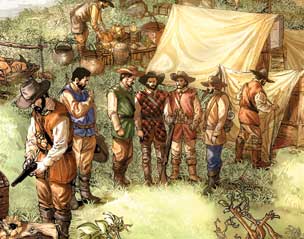 Sao Paulo's history only makes sense once you realize it's role in the inevitable gold rush that was precipitated by bandeirantes... What are bandeirantes?
Sao Paulo's history only makes sense once you realize it's role in the inevitable gold rush that was precipitated by bandeirantes... What are bandeirantes?From v-Brazil.com, which has more:
Bandeirantes were the organizers of bandeiras (bandeira is the Portuguese for "flag"; the bandeiras used to carry a flag to identify them), private expeditions which explored the interior lands of Brazil during the century 17 and in the early years of century 18.
Portugal had a limited interested in exploring the vast lands of Brazil; for decades after the discovering, all that Portugual did was to establish some trading points along the coast, barely enough to store the goods (mostly wood, minerals and stones) which would be sent to the metropolis. Besides, Portugal was restrained by the Treaty of Tordesillas, which determined the boundaries between Portuguese and Spanish domains; the bandeirantes had no limits to respect.
The bandeirantes were, above all, greedy men. They wanted the wealthiness that the Portuguese didn't bother to explore. Their goal was not to conquer land (as it was happening in the US), but to find gold, stones, and to imprison indians which would be sold as slaves.
A typical bandeira would consist of 2-3 hundred men, who would stay for months or years exploring the wild forests and fields. Each bandeira had to be organized and paid for by someone who had to be rich and bold; on return, these men would become richer and more respected by the community.
A Brief History of Sao Paulo
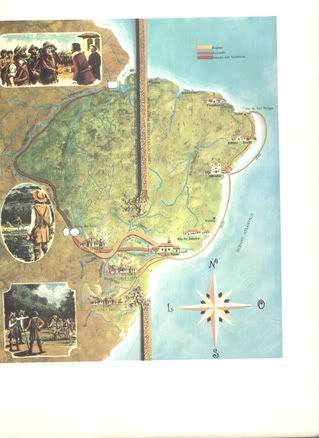 The history of this city is fascinating...
The history of this city is fascinating...Shipwrecked sailors & Jesuit priests
explorers seeking out jewels & gold leaf
Bandeirantes hoarding slaves & treasures
coffee & sugarcane in equal measure...
from aboutsaopaulo.com:
Today, São Paulo is the richest and most important State of Brazil, and São Paulo (besides being one of the oldest) is the largest city in Brazil.
However, until the early 18th century, São Paulo was not that important. São Paulo didn't have the same privileged position of Bahia, which was in the middle of the shortest path between Portugal and the Eastern Indians and became the first administrative center of Brazil. Likewise, the culture of sugar cane which flourished for a while in the 16th century in São Paulo could not compete with the producers of Pernambuco, in the Northeast of Brazil, much closer to markets in Europe.
In the 17th century, thanks to the persistence of the bandeirantes, the gold mines in Brazil were found; the mines were originally situated in São Paulo, but the King of Portugal decided to create a new province, Minas Gerais, with jurisdiction over the mines, and a new capital, Rio de Janeiro, through which the gold should be exported to Europe.
It was only in the 19th century that São Paulo started to gain relevance. Coffee had first been introduced in Rio de Janeiro, but soon the lands of São Paulo proved to be much more propicious for the new culture.
Coffee became the major Brazilian product. With the movement to abolish slavery, farmers from São Paulo realized that it would be better to hire European salary-men rather than slaves. The Europeans brought their culture and a huge willing to work and succeed. When the coffee importance declined, the Europeans moved to the cities and started businesses. In the 20th century, after Brazil became a Republic, São Paulo took also the political power.
The mixture of money, power and hard work led São Paulo to become the largest and most important State in Brazil today.
Sunday, October 30, 2011
Sounds from Sao Paulo (Vol.1) - DJ Marky
Chegada
 Said goodbye to my wife in Bangkok, and after 30+ hours I landed in Sao Paulo after an interminable journey through multiple planes and airports. You know you've been on a long trip when you've managed to watch 8 feature length movies along the way. Sleep deprived and unshaven, I breezed through immigration and customs and found my ride waiting to drive me back to the Hilton Morumbi Hotel. Got into the front seat and spent the better part of a half hour talking to my new friend Marco, who kept me entertained on the long ride through the city. Marco clued me into the common perception that "people in Sao Paulo work, while in the rest of Brazil people are more relaxed." Driving through clogged city highways, this distinction made sense to my jet lagged mind, and I tried to ward off my secret desire for a sun drenched beachfront Brazilian adventure with the admonition that I am here to work, and only that. A week in a conference room lies ahead... But still...this place is magic, and Brazil still fascinates me to no end. Any way I look at it, it is a privilege to grace these shores again, and I look forward to the rhythms of this metropolis weaving their way into my week here. Brazil is a feast, and its many flavors await anyone who cares to listen...
Said goodbye to my wife in Bangkok, and after 30+ hours I landed in Sao Paulo after an interminable journey through multiple planes and airports. You know you've been on a long trip when you've managed to watch 8 feature length movies along the way. Sleep deprived and unshaven, I breezed through immigration and customs and found my ride waiting to drive me back to the Hilton Morumbi Hotel. Got into the front seat and spent the better part of a half hour talking to my new friend Marco, who kept me entertained on the long ride through the city. Marco clued me into the common perception that "people in Sao Paulo work, while in the rest of Brazil people are more relaxed." Driving through clogged city highways, this distinction made sense to my jet lagged mind, and I tried to ward off my secret desire for a sun drenched beachfront Brazilian adventure with the admonition that I am here to work, and only that. A week in a conference room lies ahead... But still...this place is magic, and Brazil still fascinates me to no end. Any way I look at it, it is a privilege to grace these shores again, and I look forward to the rhythms of this metropolis weaving their way into my week here. Brazil is a feast, and its many flavors await anyone who cares to listen...